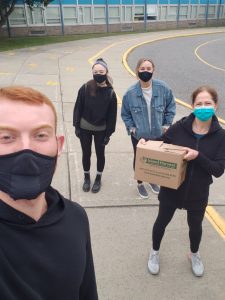-
Island Harvest Food Drive Experience

Island Harvest Food Drive Experience
Written by Lucas Skolkin
Food insecurity is the reduction in the quantity and quality of food due to a lack of money and, believe it or not, is a big problem on Long Island. Thankfully, there are places like Island Harvest.
Island Harvest was created in 1992 by Linda Breitstone who was infuriated that perfectly edible food from local convenience stores was being thrown away at the end of the day. She went around collecting and redistributing these foods “to end hunger and reduce food waste on Long Island.”
Island Harvest is now Long Island’s largest hunger-relief organization, delivering millions of pounds of surplus food – much of which might otherwise go to waste – to a network of 570 Long Island-based food pantries, soup kitchens and other non-profit organizations that offer feeding services to those in need.
I recently spent time volunteering with Island Harvest and the experience really moved me. This is the first time I got involved with my community thanks to Professor Jill Silverman, the instructor for my Community Nutrition class. We met at a school in Central Islip and spent time packaging the donated items; squash, apple sauce, canned foods, apples, cooking oil and corn. As cars lined up we deposited these packages into the trunks of their cars. Many of the cars had babies and small children.
As mentioned, food insecurity on Long Island is a huge issue. Approximately 284,000 Long Islanders will suffer from food insecurity at some point this year, and 39% of those hungry are children. Food insecurity will be even higher this year due to the effects of COVID layoffs and school closures. Many families do not have enough income to supply all members of their family with adequate amounts of healthy foods so food insecurity not only affects the amount of foods consumed but the nutritional values, as well.
As someone who will soon be working in the nutrition field, I believe it is important to encourage food insecure families to take advantage of programs and volunteer-based organizations such as Island Harvest to provide their family with enough healthy food to meet their needs. Unfortunately, many people don’t know these resources exist which is why spreading the word is so important.
Check out Island Harvest’s website here:
https://www.islandharvest.org/
You can also find them on Instagram here:
https://www.instagram.com/islandharvest/
Thanks for reading! Please check out the information below and have a great day!

Dale News Fall 2020
Dale News Online Publication: November 2020
Dale News Board Members & Important Links:
Dale News Chief Editor & Correspondent, Isaiah Hilman-Smalls
== hilmin@farmingdale.edu
Dale News Faculty Advisor, Dr. Noel Holton Brathwaite
== brathwnh@farmingdale.edu
Dale News Chief Operating Officer & Lead Journalist, Kaitlyn Hand
== handkk@farmingdale.edu
Dale News Radio Show Host & Executive Reviewer, Matthew Martorana
== martmj5@farmingdale.edu
Dale News Executive Reporter, Dante Ciprano
== ciprdm3@farmingdale.edu
Dale News Lead Broadcaster, Adina Shahzhad
== shaha18@farmingdale.edu
Dale News Official Email
== dalenewsfsc@farmingdale.edu
Farmingdale State College Website
== https://www.farmingdale.edu/
Dale News Instagram
== https://www.instagram.com/fsc_dalenews/
Dale News Ultimate Mobile Link Experience
== https://bio.fm/dalenewsfsc

